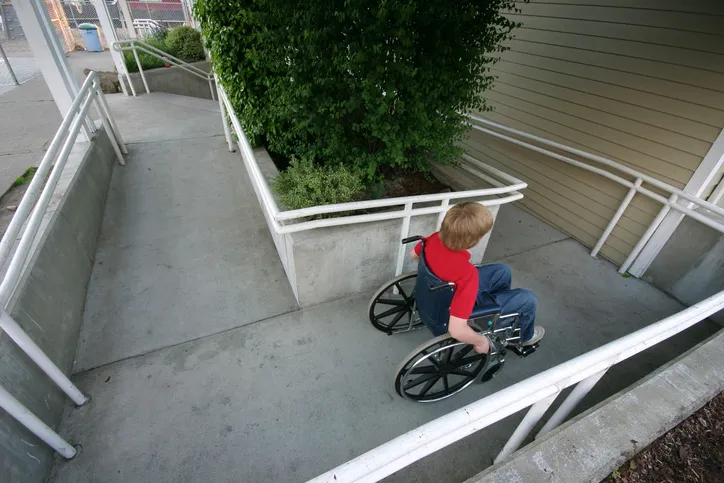
There is a moral responsibility, rooted in basic civil rights, to make buildings and elements accessible to and usable by people with disabilities. This includes persons with the inability to walk, difficulty walking, reliance on walking aids, blindness and visual impairment, deafness and hearing impairment, incoordination, reaching and manipulation disabilities, lack of stamina, difficulty interpreting sensory information, and extremes of physical size. It is also the law to provide accessibility, regulated at the federal level through the 2010 ADA Standards for Accessible Design.
The American National Standard ICC A117.1-2017 – Accessible and Usable Buildings and Facilities coordinates between this regulation and its own provisions for accessibility in buildings.
What is Covered by ANSI A117.1-2017?
In addition to the Americans with Disabilities Act (ADA) regulations, the ICC A117.1-2017 standard (also known as ANSI A117.1) is consistent with the U.S. Department of Housing and Urban Development (HUD) Fair Housing Accessibility Guidelines. Furthermore, as a publication by the International Code Council (ICC), the standard is compatible with the building code. Alignment with the building code is part of a continuous effort by the Accredited Standards Committee A117 on Architectural Features and Site Design of Public Buildings and Residential Structures for Persons with Disabilities, who approved the 2017 version of this standard, interestingly marking the 30th anniversary of the ICC as Secretariat.
ICC A117.1-2017, simply put, offers technical criteria for making sites, facilities, buildings, and related elements accessible. However, the ways in which these concerns are addressed is incredibly thorough, in a comprehensive approach to the many accessibility considerations that one must examine when constructing a new building. For example, the document, while using the aid of clear figures that visualize dimensions, specifies appropriate clearance, protruding objects, reach ranges, and acceptable routes, among many other interests for an administrative authority to provide scoping provisions.
The ICC A117.1-2017 standard is intended to be adopted by government agencies, as well as organizations setting model codes to achieve uniformity in the technical design criteria in building codes and other regulations.
Changes to ICC/ANSI A117.1-2017
As the latest revision of the standard for accessible and usable buildings and facilities, ICC A117.1-2017 has undergone several changes that differentiate it from the previous editions. Many of these serve to expand the reach of the document and address the problems or needs that arose during the revision process. Notable alterations to the standard revision include the addition of:
- Enhanced dimensions for clear floor spaces and turning spaces, introduced in response to technical data on the space needed by persons using scooters and some types of motorized wheelchairs and applicable only to new buildings and facilities
- Exterior routes
- Curb cuts
- Blended transitions
- Clarity for detectable warnings
- Passenger drop offs and parking requirements coordinated with the Public Rights of Way Guidelines
- Acoustic standards for classrooms
- Features allowing for better communication for persons using sign language
- Provisions that address the recharging of wheelchairs in hotels
- Access to gaming machines and tables
- Provisions for water bottle filling stations
There is also an errata document to this standard, ICC A117.1-2017: Errata – Accessible and Usable Buildings and Facilities, which you can download free from the ANSI Webstore.
ICC A117.1-2017 – Accessible and Usable Buildings and Facilities is available on the ANSI Webstore.






Accessibility and Universal Design have been crucial elements to make buildings functional. I believe the step ANSI 117.1-2017 has taken to adjust our built environment to function around a motorized wheelchair or scooter is taking away from the priority of functionality for humans.
As designers of the built environment we need to account for the permanence a building has vs. the temporary use of a motorized “vehicle”. We have learned from history (I hope) that building our cities around the car created extremely negative consequences. Today we are struggling to fix those issues by pushing our creativity to use our resources efficiently.
Why can’t we push design of wheelchairs to make the experience of the user accessible instead of pushing our buildings to be larger to accommodate primitive wheelchair design?
That is an interesting take on these changes. I would offer the following for your consideration. The history of the built environment has always favored the able bodied. Historically the feeble and infirm died for lack of care, so longevity of buildings was not a concern for those people.
As society and technologies have evolved, we are living longer with differing abilities. While a person using a mobility device may be temporary in the life of a building, there will always be need for mobility devices until we perfect bionic bodies. When technology and economics transcend disabilities, I am sure we will change the accessibility standards to reflect those new paradigms.
Motorized wheelchairs and scooters are an evolving technology and have in fact gotten smaller, but the widespread use has increased as they become more affordable. I would counter that we are in fact making mobility devices more efficient and adaptable. Larger turning clearances actually benefit everyone not just those who need mobility devices. Your statement, “taking away from the priority of functionality for humans” is a bit callous. People with mobility and other challenges are Humans.
I think we are at a good balance point between providing accessibility and functionality. Discourse will continue to keep that balance, so thank you for your thoughts on the topic.
I’m a Commissioner for the ageing in my County whose population now includes 30% and growing of people over 65 as are many Counties/States in the US and overseas. Many of the residences for the elderly have had to be adjusted once their owners began to age so that they could continue safely to live in those homes. Most often if they cannot afford adjustment they make costly lateral changes—leave family homes and move to apartments or condominiums where cost may equal r be higher than what they might have experienced in their family home. Outdated designs of residences built for young healthy families are the culprit as they no longer serve the needs of the elderly. New residences are constructed, often promoted as accessible senior housing. The term “accessible” however only reflects the subsidized cost by the County. Building codes to reflect senior needs are not reflected in the ADA codes and the County seems reluctant to ask developers to make changes to the cookie-cutter housing they create. A few simple changes culled from Universal design would ensure that as people age they can remain in their residences. One simple change would be for all developers to ensure that in any type of residential housing—from town houses to free-standing homes—one bedroom (preferably master) should be on the ground floor and one bathroom also made available on that floor. That bathroom should have some of the features specified in universal design—walk-in showers, grab bars and space for a wheelchair or walker to enter and electrical outlets raised from floor level. That floor should also have accessible paths to kitchens and laundry. Entrances should not include steps.